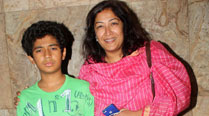 I can always survive as a painter as I have done for a significant a part of my life,” says writer-director Amole Gupte when asked about why his protagonists are often put in a position of disadvantage.
I can always survive as a painter as I have done for a significant a part of my life,” says writer-director Amole Gupte when asked about why his protagonists are often put in a position of disadvantage.
IF I want to present the portrait of a child, I want to do that with a story. There is scope for discovering that child through a story. While doing so, there are more strokes and colours to explore than presenting a standard middle-class child. Otherwise, it is not going to excite me. I can always survive as a painter as I have done for a significant a part of my life,” says writer-director Amole Gupte when asked about why his protagonists are often put in a position of disadvantage. A case in point: Sunny Gill (played by Khushmeet Gill), protagonist of Sniff!!! of last Friday’s release, who can’t even smell the overpowering spices in his grandmother’s special pickles.
For Gupte, the stories of such characters, who can be termed as the proverbial “underdogs”, are like sugar-coated pills. “I have to serve such pills. Otherwise, there are enough people serving entertainment, entertainment and entertainment. That’s such a haughty formula. When there is a need to bring out an issue, we have to table it in an acceptable way. Once the audience ingests the issue, there is scope for change,” says Gupte, a theatre artiste and painter who is today known for his sensitive children’s movies.
Gupte’s movies are a reflection of his firm belief that once “the audience adopts the centerpiece, they would eventually carry home the message.”
Earlier, the 54-year-old was the creative director of Taare Zameen Par (2007), which explores the trials of an eight-year-old dyslexic boy who is seen as a troublemaker. Gupte directed Stanley Ka Dabba (2011), which showcased the magic of a child’s imagination and talked about the harassment he encounters, as well as Hawaa Hawaai (2014), which is about a poor boy without a father who nurses dreams of skating. In Sniff!!!, which has received mixed reviews, Sunny eventually goes on to acquire a strong sense of smell and a nose for solving crimes. In fact, he is called India’s first spy-superhero and this film is the first installment of a franchise by Trinity Pictures for the young audience. Though Sniff!!! revolves around adventures of Sunny and his friends, it also captures the idiosyncratic life of Mumbai’s Bima Nagar, where Gupte grew up. Some of its residents also feature in the cast. He has also recently made a short film titled One Idiot that encourages teenagers to start saving early.
The writer-director rues that not enough parents are bringing children to theatres. “When they take their child to a U/A film, which has an item number and bawdy jokes, bachha bhi khush, bachhe ki baap bhi khush (the child as well as his parents are happy ). In the Scandinavian countries, however, children’s films have a bigger market as parents watch them along with their children,” he adds. True to his observation, we found more children waiting in the foyer to watch Toilet: Ek Prem Katha with their parents than at the auditorium screening Sniff!!!. Interestingly, even though its shows were listed on publicity materials, they were discontinued at the multiplex.
Gupte swears by the power of cinema to impact young minds, positively. The director, who was involved with a social organisation for nine years, would conduct workshops, classes on theatre and cinema for children on Saturday afternoons. “Just because someone is financially backward does not mean they don’t enjoy the right to be artists. Their understanding of visual art is amazing — be it Impressionism or the Renaissance,” says Gupte and recounts how a group of young audience was “stunned and struck” when he showed them Satyajit Ray’s Pather Panchali. He even found Khushmeet during a similar free workshop in a Mumbai gurudwara. Like in case of his previous movies, Gupte ensured that none of the young actors missed school during the shoot.
Given the commercial concerns that drive Indian cinema, what’s the ideal children’s film? “Something which will draw the audience. Both Taare Zameen Par and Bajarangi Bhaijan have a star. Yet, they can qualify as children’s films as they have some lovely strokes, even if they are broad ones. There is no point in searching for Majid Majidi in Bajrangi Bhaijaan. Yet, the movie sensitises the audience about a child’s disability,” he says. These are, of course, stray instances. “More such films are required where a star sacrifices his broad bandwidth and instead earns a halo behind,” adds Gupte, whose next film is a biopic on Olympic medal-winner Saina Nehwal.

